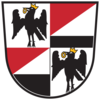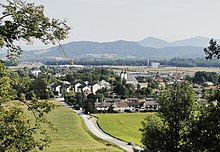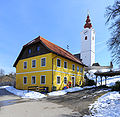Ebenthal in Carinthia
|
market community Ebenthal in Carinthia
|
||
|---|---|---|
| coat of arms | Austria map | |
|
|
||
| Basic data | ||
| Country: | Austria | |
| State : | Carinthia | |
| Political District : | Klagenfurt-Land | |
| License plate : | KL | |
| Surface: | 55 km² | |
| Coordinates : | 46 ° 37 ' N , 14 ° 21' E | |
| Height : | 415 m above sea level A. | |
| Residents : | 8,065 (January 1, 2020) | |
| Population density : | 147 inhabitants per km² | |
| Postal code : | 9065 | |
| Area code : | 0463 | |
| Community code : | 2 04 02 | |
| NUTS region | AT211 | |
| Address of the municipal administration: |
Miegerer Strasse 30 9065 Ebenthal in Carinthia |
|
| Website: | ||
| politics | ||
| Mayor : | Franz Felsberger ( SPÖ ) | |
|
Municipal Council : ( 2015 ) (27 members) |
||
| Location of Ebenthal in Carinthia in the Klagenfurt-Land district | ||
| Source: Municipal data from Statistics Austria | ||
Ebenthal ( Slovenian : Žrelec ) is a market town with 8065 inhabitants (as of January 1, 2020) in the Klagenfurt-Land district in Carinthia .
geography
Ebenthal is located in the south-east of Klagenfurt . The Sattnitz mountain range stretches from west to east and is a popular local recreation area due to its wooded area. The rivers Glan and Gurk flow through Ebenthal , the only outflow from the nearby Wörthersee , the Glanfurt , flows into the Glan near the center of the village. The southern border of Ebenthal is the Radsberg, which has been part of Ebenthal for some time.
The Höflein-Moor nature reserve is located in the municipality .
Community structure
Ebenthal is divided into ten cadastral communities : Ebenthal ( Žrelec ), Gradnitz ( Gradnice ), Gurnitz ( Podkrnos ), Hinterberg, Kreuth ( Rute ), Lipizach ( Lipica ), Mieger ( Medgorje ), Radsberg ( Radiše ), Rottenstein ( Podgrad ), Zell near Ebenthal ( Selo )
The municipality includes the following 34 localities (population in brackets as of January 1, 2020):
- Aich an der Straße ( Dobje ) (18)
- Mountain ( Rute pri Medgorjah ) (77)
- Ebenthal ( Žrelec ) (1397)
- Goritschach ( Goriče ) (59)
- Gradnitz ( Gradnice ) (487)
- Gurnitz ( Podkrnos ) (405)
- Haber ( Gaber ) (46)
- Hinterberg (12)
- Kohldorf ( Vogle ) (69)
- Kosasmojach ( Kozasmoje ) (28)
- Kossiach ( Kozje ) (58)
- Kreuth ( rod ) (139)
- Lipizach ( Lipica ) (84)
- Mieger ( Medgorje ) (11)
- Moosberg ( Kajže ) (16)
- Niederdorf ( Dolnja vas ) (1088)
- Obermieger ( Zgornje Medgorje ) (84)
- Obitschach ( Običe ) (145)
- Pfaffendorf ( Hovja vas ) (166)
- Priedl ( Predel ) (109)
- Radsberg ( Radiše ) (95)
- Rain ( Breg ) (1061)
- Reichersdorf ( Riharja vas ) (730)
- Rosenegg ( Rožneci ) (277)
- Rottenstein ( Podgrad ) (117)
- Saager ( Zagorje ) (12)
- Sabuatach ( Zablate ) (12)
- Black ( Dvorec ) (195)
- Tutzach ( Tuce ) (122)
- Untermieger ( Spodnje Medgorje ) (35)
- Werouzach ( Verovce ) (30)
- Zell ( Selo ) (310)
- Shredding ( Cotarija ) (449)
- Zwanzgerberg ( Osojnica ) (122)
Other locations are the Rotte Mühlgraben and the scattered settlements of Oberkreuth and Unterkreuth .

Neighboring communities
| Klagenfurt | Poggersdorf | |
| Maria Rain |

|
Grafenstein |
| Ferlach | Sankt Margareten im Rosental | Gallicia |
Waters
history
In 860, King Ludwig the German gave the Archbishop of Salzburg Adalwin extensive possessions, including a farm in Carinthia on Gurnitz . In 984, the then place name Schrelz was first mentioned in a document. On the steep northern slope of the Sattnitz , the Salzburg archbishopric had Greifenfels Castle built in the 12th century to secure its possessions . This castle came to the Neuhaus knight family as a fief in 1404 . At the foot of the castle, Christoph von Neuhaus built a noble man's seat in 1566, which was mentioned in a document on September 14, 1567 under the name Ebenthal. In 1704 the Counts of Goëss bought the possessions; Ebenthal Castle is still owned by the Goëss family today.
In 1792 Ebenthal was raised to an independent branch and in 1906 to an independent parish . Thirty years later, Ebenthal had around 250 residents and 40 houses.
Ebenthal was traditionally home to many Carinthian Slovenes who made up the majority of the community's population until the end of the 19th century. The coexistence with the members of the German ethnic group was mostly harmonious and fruitful, but at times also shaped by conflicts.
An important event was the Carinthian defensive battle between Carinthia and the SHS state in the years 1918 to 1920. The Klagenfurt-Land district was then divided by the demarcation line. After a referendum it was decided that the southern part of Carinthia will remain with Austria.
On April 14, 1942, the Nazi regime set up a temporary storage facility in Ebenthal for 1075 Slovenes who had been expropriated, declared enemies of the state and forcibly deported . Half of them were children and adolescents. The youngest inmate was 17 days old, the oldest 88 years old. A memorial stone in the community today commemorates this episode.
Ebenthal was constituted as a political municipality in 1850 and was subsequently spared from incorporation as the only peripheral municipality in Klagenfurt. In the course of the amalgamation of the parishes, the Radsberg parish, a large part of the Mieger parish, as well as smaller parts of the Klagenfurt and Maria Rain and Grafenstein parishes became part of Ebenthal on January 1, 1973, which meant a considerable expansion of the community area.
From 1973 to 1997 the spelling of the community name was "Ebental". This changed on January 1st, 1998, when it was decided to rename it “Ebenthal in Kärnten” at the same time as the market survey.
population
Ebenthal had 7,427 inhabitants at the time of the census in 2001, 96.7% of whom were Austrian citizens. 4.2% belonged to the Slovene-speaking ethnic group. 81% committed themselves to the Roman Catholic Church , 5% to the Protestant Church . About 10% of the community population were without religious beliefs.
The Slovenian dialect
Historically, the municipality of Ebenthal belongs to the Slovene dialect area (dialect) of the Klagenfurt field , which is a transition dialect between the Slovene dialects of the Jaun Valley ( podjunščina ) and the Rosental ( rožanščina ). Johann Scheinigg identified it as a special variant of the Slovenian Rosental dialect in 1882, which was confirmed in the dialectological study by Katja Sturm-Schnabl based on field research. In his work "Die Assimilation ...", Scheinigg divides the Slovene Rosental dialect into three geographical areas: the Lower Rosental, the Upper Rosental and the Klagenfurt Plain. Regarding the latter area, he says: “... The third sub-dialect prevails in the plain around Klagenfurt (kl.), It has the pronunciation of the e and o in common with the first, but differs from the two previous ones in that it is frequently withdrawn of the accent, where those have it on the final syllables; this is especially true of the neuter of nouns and adjectives, e.g. B. [...] " .
The Slovenian cultural association Radiše is based in Radsberg.
Culture and sights
Churches
- Ebenthal parish church in Carinthia
- Provost and parish church hl. Martin in Gurnitz
- Parish church hl. Bartholomäus in Obermieger
- Parish church hl. Lambert in Radsberg
- Parish church hl. Magdalena in Rottenstein
Castles
ruins
- Bronze Age ramparts near Gurnitz
- Gurnitz castle ruins
- Greifenfels castle ruins
- Rottenstein ruins
Others
- Gurnitzer Brewery
- Ebental waterfall
- Gurnitz waterfall
- Calamus bath
- Memorial on Radsberg: To commemorate the persecution of the Carinthian Slovenes from 1942 to 1945, the Association of Resettled Slovenes erected a marble memorial west of the cultural center in the village of Radsberg in the 50th year of existence in 1996. It serves as a “reminder of the past” and as a “reminder for the future”. The ordeal began near this memorial, namely in the camp on the road from Klagenfurt to Ebenthal: the National Socialists expelled around 300 Slovenian families from the communities of Southern Carinthia and interned them in camps.
The municipality is characterized by very different parts of the landscape . The Sattnitz ridge as a middle mountain range characterizes the topographical appearance as does the fertile plain between Klagenfurt and Grafenstein , which is crossed by the flowing waters of the Drau , Glan , Glanfurt , Gurk and Raba . Fly fishing and angling are very popular. On the south side of the Sattnitz there is the possibility of hang gliding from Oberkreuth to Rottenstein im Rosental .
Economy and Infrastructure
From 1990 the market town was able to establish itself as a commercial location. Immediately on the railway line south of Niederdorf, the market community implemented a company settlement model. In the meantime, around 30 commercial companies have settled on around 16,000 m². The Niederdorf bypass, which was completed by the end of 2004, gave this company area a quick connection to the local motorway network. The Klagenfurt Ebenthal station outside the municipality is located on the Drautalbahn , and since January 2016, Stadtwerke Klagenfurt AG's bus lines have served the densely populated valley area and micro-public transport services the mountain area. An optimal traffic-technical development of the entire municipality area and an adequate connection to the state capital Klagenfurt am Wörthersee is guaranteed.
Rural architecture
politics
Municipal council
The Ebenthal municipal council has 27 members and has been composed as follows since the 2015 municipal council election :
The directly elected mayor is Franz Felsberger (SPÖ).
coat of arms
The community had a raven in its seal as early as 1945 and later decided to take over the coat of arms of the Lords of Neuhaus zu Greifenfels, the builders of Ebenthal Castle, who, after having been in the service of the Counts of Heunburg and Cilli and the Bishop of Gurk , in Carinthia became landed and in 1636 rose to the imperial freedom. The line finally died out in Bavaria in the 18th century.
The Neuhaus family coat of arms has been documented since 1456 and was expanded to include the fields with the crowned raven in the 16th century; in this respect a connection with the attribute of St. Oswald of Northumbria is possible. The municipality's coat of arms and flag were awarded on June 7, 1960. The blazon of the coat of arms reads:
- “In the first and fourth fields of the quartered shield on a silver background a black raven turned to the right, standing on the lower edge of the field, wings raised, head adorned with a golden, three-pointed crown and a golden ring in its beak; the second and third fields are divided into red and black by a silver right side tip, with the lower edge of the side tip running horizontally. "
The flag is red-white-black with an incorporated coat of arms.
Personalities
- The painter Markus Pernhart (1824–1871) was born in Untermieger
- Birthplace of the painter Wilhelm Loisel (1914-2005)
- The academic painter Karl Truppe (1887–1959) was born on February 9, 1887 in Werouzach
- Governor Ferdinand Wedenig (1896–1975) was born in Gurnitz
- The roots of the family of Federal Chancellor Kurt Schuschnigg (1897–1977) lie in Radsberg. The family was originally of Slovene-Carinthian descent (Slovene spelling of the name Schuschnigg: "Šušnik")
- The photographer Daniel Zupanc (* 1969) lives in Gradnitz
literature
- Tomaž Ogris: Radiše Radsberg. Drava Verlag, Klagenfurt 2009, ISBN 978-3-85435-603-5 .
- Anton Kreuzer: Land so full of smiling melancholy. The market town of Ebenthal in Carinthia. Kreuzer Buch, Klagenfurt 2010.
Web links
- Market town of Ebenthal in Carinthia
- 20402 - Ebenthal in Carinthia. Community data, Statistics Austria .
Individual evidence
- ↑ Statistics Austria: Population on January 1st, 2020 by locality (area status on January 1st, 2020) , ( CSV )
- ↑ Avguštin Malle (ed.): The expulsion of the Carinthian Slovenes / Pregon Koroških Slovencev 1942–2002. Drava Verlag, 2002, ISBN 3-85435-387-1 .
- ^ Johann Scheinigg: The assimilation in the Rosenthaler dialect, A contribution to the Carinthian-Slovenian dialect research. Published in the XXXII program of the kk Staatsgymn in Klagenfurt 1882. Quoted from: Katja Sturm-Schnabl: The Slovenian dialects and dialect remnants in the Klagenfurt basin. phil. Diss. Vienna 1973, p. 33.
- ↑ Slovenskko prosveno društvo Radiše: http://www.spd-radise.at/SPD_Radise/domov_Home.html
- ^ Quoted from Wilhelm Deuer: The Carinthian municipal coat of arms . Publishing house of the Kärntner Landesarchiv, Klagenfurt 2006, ISBN 3-900531-64-1 , p. 74.






















